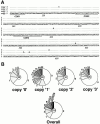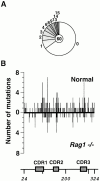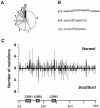Somatic hypermutation in the absence of DNA-dependent protein kinase catalytic subunit (DNA-PK(cs)) or recombination-activating gene (RAG)1 activity
- PMID: 11085752
- PMCID: PMC2193187
- DOI: 10.1084/jem.192.10.1509
Somatic hypermutation in the absence of DNA-dependent protein kinase catalytic subunit (DNA-PK(cs)) or recombination-activating gene (RAG)1 activity
Abstract
Somatic hypermutation and isotype switch recombination occur in germinal center B cells, are linked to transcription, and are similarly affected by deficiency in MutS homologue (MSH)2. Class-switch recombination is abrogated by disruption of genes encoding components of the catalytic subunit of DNA-dependent protein kinase (DNA-PK(cs))/Ku complex and likely involves nonhomologous end joining (NHEJ). That somatic hypermutation might also be associated with end joining is suggested by its association with the creation of deletions, duplications, and sites accessible to terminal transferase. However, a requirement for NHEJ in the mutation process has not been demonstrated. Here we show that somatic mutation in mice deficient in NHEJ can be tested by introduction of rearranged immunoglobulin and T cell receptor transgenes: the transgene combination not only permits reconstitution of peripheral lymphoid compartments but also allows formation of germinal centers, despite the wholly monoclonal nature of the lymphocyte antigen receptors in these animals. Using this strategy, we confirm that somatic hypermutation like class-switching can occur in the absence of recombination-activating gene (RAG)1 but show that the two processes differ in that hypermutation can proceed essentially unaffected by deficiency in DNA-PK(cs) activity.
Figures




Comment in
-
Error-prone candidates vie for somatic mutation.J Exp Med. 2000 Nov 20;192(10):F27-30. doi: 10.1084/jem.192.10.f27. J Exp Med. 2000. PMID: 11085756 Free PMC article. No abstract available.
Similar articles
-
V(D)J recombination catalyzed by mutant RAG proteins lacking consensus DNA-PK phosphorylation sites.Mol Immunol. 1999 Dec;36(18):1263-9. doi: 10.1016/s0161-5890(99)00099-1. Mol Immunol. 1999. PMID: 10684966
-
Reduced switching in SCID B cells is associated with altered somatic mutation of recombined S regions.J Immunol. 2003 Dec 15;171(12):6556-64. doi: 10.4049/jimmunol.171.12.6556. J Immunol. 2003. PMID: 14662857
-
Deficiency in Msh2 affects the efficiency and local sequence specificity of immunoglobulin class-switch recombination: parallels with somatic hypermutation.EMBO J. 1999 Jun 15;18(12):3484-90. doi: 10.1093/emboj/18.12.3484. EMBO J. 1999. PMID: 10369687 Free PMC article.
-
Immunoglobulin gene hypermutation in germinal centers is independent of the RAG-1 V(D)J recombinase.Immunol Rev. 1998 Apr;162:133-41. doi: 10.1111/j.1600-065x.1998.tb01436.x. Immunol Rev. 1998. PMID: 9602359 Review.
-
How to make ends meet in V(D)J recombination.Curr Opin Immunol. 2001 Apr;13(2):186-94. doi: 10.1016/s0952-7915(00)00203-x. Curr Opin Immunol. 2001. PMID: 11228412 Review.
Cited by
-
Somatic hypermutation in human B cell subsets.Springer Semin Immunopathol. 2001 Dec;23(4):367-85. doi: 10.1007/s281-001-8165-0. Springer Semin Immunopathol. 2001. PMID: 11826615 Review. No abstract available.
-
Disparate roles of ATR and ATM in immunoglobulin class switch recombination and somatic hypermutation.J Exp Med. 2006 Jan 23;203(1):99-110. doi: 10.1084/jem.20050595. Epub 2006 Jan 3. J Exp Med. 2006. PMID: 16390936 Free PMC article.
-
Immunoglobulin class-switch recombination deficiencies.Arthritis Res Ther. 2012 Jul 30;14(4):218. doi: 10.1186/ar3904. Arthritis Res Ther. 2012. PMID: 22894609 Free PMC article. Review.
-
Activation-induced deaminase (AID)-directed hypermutation in the immunoglobulin Smu region: implication of AID involvement in a common step of class switch recombination and somatic hypermutation.J Exp Med. 2002 Feb 18;195(4):529-34. doi: 10.1084/jem.20012144. J Exp Med. 2002. PMID: 11854365 Free PMC article.
-
Know your enemy or find your friend?-Induction of IgA at mucosal surfaces.Immunol Rev. 2021 Sep;303(1):83-102. doi: 10.1111/imr.13014. Epub 2021 Jul 30. Immunol Rev. 2021. PMID: 34331314 Free PMC article. Review.
References
-
- Frey S., Bertocci B., Delbos F., Quint L., Weill J.-C., Reynaud C.-A. Mismatch repair deficiency interferes with the accumulation of mutations in chronically stimulated B cells and not with the hypermutation process. Immunity. 1998;9:127–134. - PubMed
-
- Rada C.A., Ehrenstein M.R., Neuberger M.S., Milstein C. Somatic hypermutation in MSH2 deficient mice is more focussed on intrinsic hotspots suggesting targeting to be a two stage process. Immunity. 1998;9:135–141. - PubMed
Publication types
MeSH terms
Substances
LinkOut - more resources
Full Text Sources
Molecular Biology Databases

